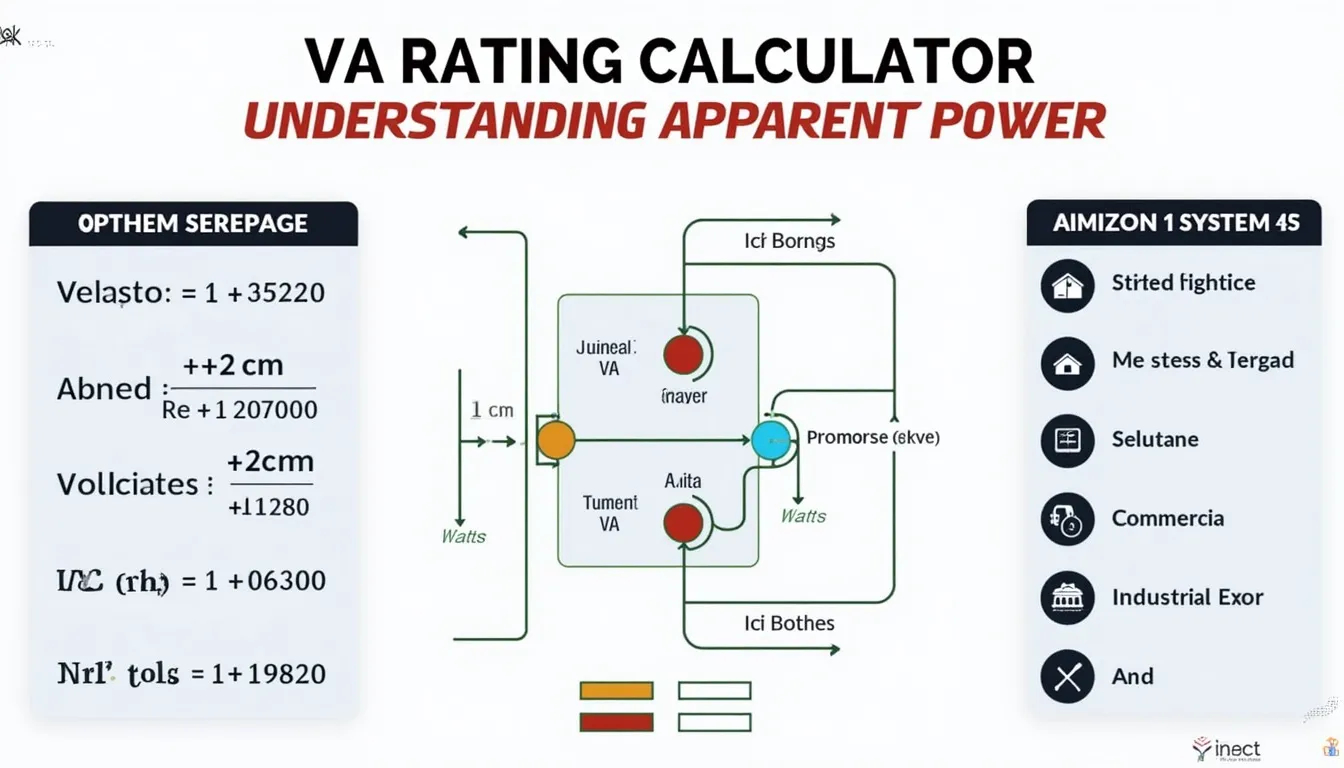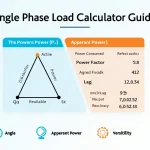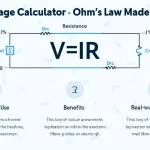Is this tool helpful?
How to Use the VA Rating Calculator Effectively
The VA Rating Calculator is a powerful tool designed to help electrical professionals and enthusiasts calculate the apparent power (VA) in electrical systems. Here’s a step-by-step guide on how to use this calculator effectively:
1. Enter the Voltage
In the “Voltage (V)” field, input the system voltage in volts. For example, you might enter “230” for a standard residential voltage in many countries.
2. Input the Current
In the “Current (A)” field, enter the load current in amperes. A typical value might be “10” for a moderate household appliance.
3. Select the Phase Type
Choose between “Single-phase” and “Three-phase” from the dropdown menu. This selection is crucial as it determines the calculation method used.
4. Optional: Enter the Power Factor
If you know the power factor of your system, enter it in the “Power Factor” field. This value should be between 0 and 1. For instance, “0.8” is a common power factor for many electrical systems.
5. Calculate the Results
Click the “Calculate” button to generate the results. The calculator will display the VA Rating and, if a power factor was provided, the Real Power in watts.
Understanding VA Rating: Definition, Purpose, and Benefits
VA Rating, short for Volt-Ampere Rating, is a crucial concept in electrical engineering that represents the apparent power in an electrical system. It’s the product of voltage and current, indicating the total amount of work potential in an electrical system.
Definition of VA Rating
VA Rating is defined as the mathematical product of voltage (in volts) and current (in amperes) in an electrical circuit. For single-phase systems, it’s a straightforward multiplication, while for three-phase systems, an additional factor is involved.
Purpose of VA Rating Calculations
The primary purpose of calculating VA Rating is to determine the capacity requirements of electrical equipment such as transformers, generators, and uninterruptible power supplies (UPS). It helps engineers and technicians to:
- Size electrical components correctly
- Prevent overloading of circuits
- Ensure efficient power distribution
- Plan for future electrical load expansions
Benefits of Using a VA Rating Calculator
Utilizing a VA Rating Calculator offers numerous advantages:
- Accuracy: Eliminates human error in complex calculations
- Time-saving: Provides instant results for quick decision-making
- Versatility: Handles both single-phase and three-phase calculations
- Educational value: Helps users understand the relationship between voltage, current, and power
- Cost-effective planning: Aids in selecting appropriately sized equipment, avoiding unnecessary expenses
The Mathematics Behind VA Rating Calculations
Single-Phase VA Rating Formula
For single-phase systems, the VA Rating is calculated using the following formula:
$$VA = V \times I$$Where:
- VA = Volt-Ampere Rating
- V = Voltage (in volts)
- I = Current (in amperes)
Three-Phase VA Rating Formula
For three-phase systems, the calculation is slightly more complex:
$$VA = \sqrt{3} \times V \times I$$Where:
- VA = Volt-Ampere Rating
- V = Line-to-line voltage (in volts)
- I = Line current (in amperes)
- √3 ≈ 1.732 (square root of 3)
Real Power Calculation (When Power Factor is Known)
If the power factor is provided, the calculator can also determine the real power:
$$P = VA \times PF$$Where:
- P = Real Power (in watts)
- VA = Volt-Ampere Rating
- PF = Power Factor (a value between 0 and 1)
Addressing User Needs: Practical Applications of VA Rating Calculations
Sizing Electrical Equipment
One of the primary applications of VA Rating calculations is in sizing electrical equipment. Let’s consider an example:
Suppose you need to select a transformer for a small office building. You’ve determined that the maximum load current is 100 A at 240 V in a single-phase system.
Using the VA Rating Calculator:
- Enter Voltage: 240 V
- Enter Current: 100 A
- Select Phase Type: Single-phase
The calculator will show:
- VA Rating: 24,000 VA (or 24 kVA)
This means you should select a transformer rated at least 24 kVA to handle the maximum load safely.
Planning for Future Expansion
VA Rating calculations are crucial when planning for future electrical load expansions. Let’s look at another example:
A factory currently has a three-phase system operating at 415 V with a maximum current draw of 200 A. They want to plan for a 30% increase in power consumption over the next five years.
Current VA Rating:
- Enter Voltage: 415 V
- Enter Current: 200 A
- Select Phase Type: Three-phase
The calculator will show:
- VA Rating: 143,780 VA (or 143.78 kVA)
For future expansion (30% increase):
- Future VA Rating = 143.78 kVA × 1.3 = 186.91 kVA
This calculation helps the factory plan for upgrading their electrical infrastructure to accommodate future growth.
Determining Real Power Consumption
When the power factor is known, the VA Rating Calculator can help determine real power consumption. Consider this scenario:
An industrial motor operates on a three-phase, 480 V system, drawing 50 A. The power factor is known to be 0.85.
Using the calculator:
- Enter Voltage: 480 V
- Enter Current: 50 A
- Select Phase Type: Three-phase
- Enter Power Factor: 0.85
The calculator will show:
- VA Rating: 41,569 VA
- Real Power: 35,334 W (or 35.33 kW)
This information is valuable for energy management and efficiency calculations.
Practical Applications and Use Cases
Residential Electrical Planning
For homeowners or electricians working on residential projects, the VA Rating Calculator can be invaluable. It helps in:
- Sizing circuit breakers for new appliances
- Determining if existing wiring can handle additional loads
- Planning whole-house generator capacity
Commercial Building Management
Facility managers and building engineers can use the VA Rating Calculator to:
- Assess the capacity of existing electrical systems
- Plan for new tenant equipment installations
- Optimize power distribution across different building zones
Industrial Process Design
In industrial settings, the VA Rating Calculator assists engineers in:
- Designing power systems for new production lines
- Evaluating the impact of adding new machinery to existing systems
- Calculating power requirements for large motor installations
Renewable Energy Integration
For renewable energy projects, the calculator helps in:
- Sizing inverters for solar panel installations
- Determining battery storage capacity for off-grid systems
- Calculating power output potential for wind turbine installations
Frequently Asked Questions (FAQ)
Q1: What is the difference between VA and watts?
A: VA (Volt-Amperes) represents apparent power, which is the total power in an AC circuit. Watts represent real power, which is the power actually consumed. In a perfect system (power factor = 1), VA equals watts. In real-world applications, VA is typically higher than watts due to reactive power in the system.
Q2: Why is the three-phase calculation different from single-phase?
A: Three-phase systems distribute power more efficiently than single-phase systems. The √3 factor in the three-phase formula accounts for the phase relationships between the three conductors, resulting in a more accurate representation of the total power in the system.
Q3: How does power factor affect VA Rating?
A: Power factor doesn’t directly affect VA Rating, but it does impact the relationship between apparent power (VA) and real power (watts). A lower power factor means more apparent power is needed to deliver the same amount of real power, potentially requiring larger and more expensive electrical equipment.
Q4: Can I use this calculator for DC systems?
A: The concept of VA Rating is primarily used in AC systems. For DC systems, power is simply calculated as voltage multiplied by current (P = V × I), and the result is in watts. The phase type and power factor are not applicable in DC calculations.
Q5: How often should I recalculate VA Ratings in my electrical system?
A: It’s good practice to recalculate VA Ratings whenever you make significant changes to your electrical system, such as adding new equipment, changing load patterns, or upgrading infrastructure. For stable systems, an annual review is often sufficient to ensure your calculations remain accurate and your system operates within safe parameters.
Conclusion: Empowering Electrical Professionals and Enthusiasts
The VA Rating Calculator is an indispensable tool for anyone working with electrical systems. By providing quick, accurate calculations of apparent power and real power, it enables users to make informed decisions about electrical system design, equipment selection, and load management.
Whether you’re a professional electrician planning a large-scale industrial installation or a DIY enthusiast working on a home improvement project, understanding and accurately calculating VA Ratings is crucial for safety, efficiency, and cost-effectiveness.
By leveraging the power of this calculator, users can ensure their electrical systems are properly sized, prevent overloading, plan for future expansions, and optimize energy usage. The ability to quickly switch between single-phase and three-phase calculations, coupled with the option to include power factor considerations, makes this tool versatile and applicable to a wide range of scenarios.
As we continue to rely more heavily on electrical systems in our daily lives and industrial processes, tools like the VA Rating Calculator become increasingly valuable. They not only simplify complex calculations but also contribute to the overall safety and reliability of our electrical infrastructure.
Remember, while this calculator is a powerful aid, it’s always important to consult with qualified electrical professionals for critical decisions and installations. Use this tool as part of your broader electrical planning and management strategy, and you’ll be well-equipped to handle the electrical challenges of today and tomorrow.
Important Disclaimer
The calculations, results, and content provided by our tools are not guaranteed to be accurate, complete, or reliable. Users are responsible for verifying and interpreting the results. Our content and tools may contain errors, biases, or inconsistencies. We reserve the right to save inputs and outputs from our tools for the purposes of error debugging, bias identification, and performance improvement. External companies providing AI models used in our tools may also save and process data in accordance with their own policies. By using our tools, you consent to this data collection and processing. We reserve the right to limit the usage of our tools based on current usability factors. By using our tools, you acknowledge that you have read, understood, and agreed to this disclaimer. You accept the inherent risks and limitations associated with the use of our tools and services.







